Are you staring at a tangled mess that is growing all over your aquarium plants?
You might have Staghorn algae.
This branching growth, if left unchecked, can take over your entire tank!
Today, I am going to show you how to identify it, get rid of it and stop it from coming back!
Contents
What is Staghorn algae?
It’s easy to see why this algae is named after the antlers of a male deer. The branching growth of Staghorn algae would not look out of place on the head of a deer.
Healthy Staghorn algae is typically a dark gray (almost brown), light gray or white color. However, this algae can look slightly green depending on your lighting setup.
Don’t be fooled by the color, Staghorn algae is actually a member of the red algae family.
Staghorn algae most commonly grows on plants, although I have seen cases where it attached itself to rocks, aquarium decorations and even a filter pipe.
You can identify Staghorn algae by its branching growth. It starts out looking like a sapling in fall – you know, the ones that lose their leaves…
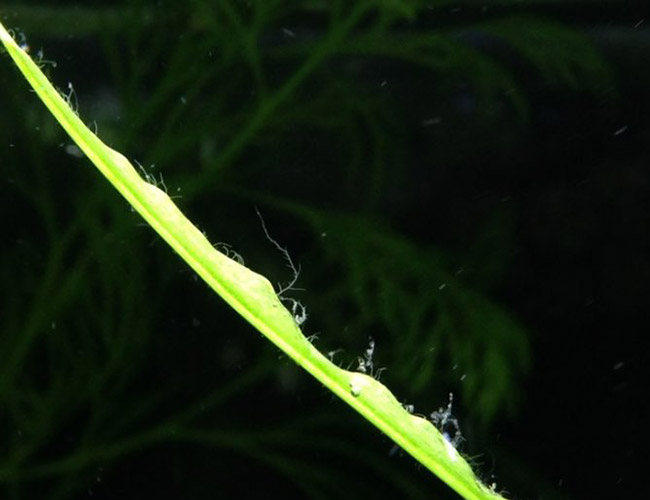
…So tiny, it can easily be missed among the much larger plants in your aquarium.
But as Staghorn algae grows, it becomes a bit more spindly…
As Staghorn algae continues to grow, it can completely cover a surface. When this happens, it almost looks like an old, messy beard…
And outside of the water, Staghorn algae still looks like antlers!
Don’t be confused with…
Staghorn algae is often confused with black beard algae. And, I can understand why – fully grown Staghorn algae looks like a wiry beard. In fact, it often looks more like a beard than black beard algae does.
So, how do you tell the two apart?
Let’s compare the two during their early stages of growth…
In the blue circle, you have black beard algae, resembling the tightly packed clusters of bristles you find on a makeup brush. Staghorn algae, circled in red, looks more like the antlers of a male deer – hence the name.
When fully grown, the two also look quite different, but unless you compare them side by side, it’s easy to see where the confusion comes from.
Fully grown black beard algae, on the left, is dense and bushy while Staghorn algae, on the right, is sparse and wiry.
Think you have black beard algae in your tank? Check out our black beard algae guide – with pictures and instructions on how to get rid of it!
Is Staghorn algae harmful to fish?
Nope, Staghorn algae does not represent a danger to your fish.
In fact, if you let your Staghorn algae grow to ridiculous proportions, many fish and shrimp explore its long and bristly growth.
Plants on the other hand…
Is Staghorn algae harmful to plants?
Yes, but not directly.
In fact, in its early stages of growth, Staghorn algae is hardly a bother at all.
But as it grows, Staghorn algae will compete with your plants for nutrients. Any nutrients that the Staghorn algae consumes are not being used by your aquarium plants.
Also, if you leave Staghorn algae to grow thick enough, it can block out light from any plants that are unlucky enough to be underneath it.
And if you know about photosynthesis, you are fully aware that light is vital for most aquarium plants to survive. Without it, they die.
So yeah, an uncontrolled spread of Staghorn algae can be particularly dangerous to plants in your aquarium.
What is the cause of Staghorn algae?
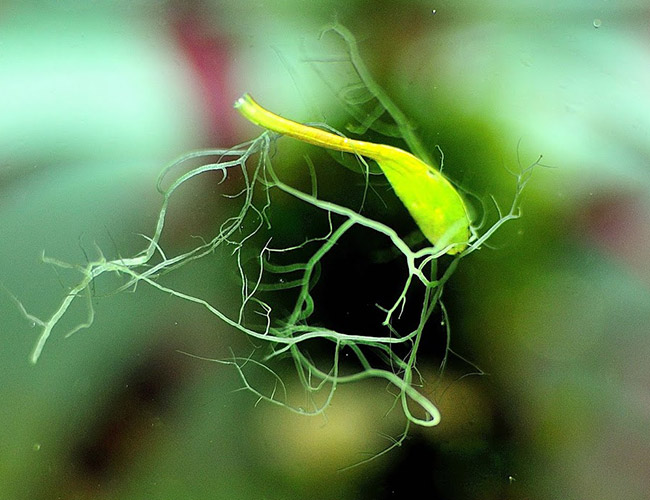
It almost feels like Staghorn algae appears by magic. One day your aquarium is algae free, and the next your plants have a gray fuzz growing over them.
There are three common causes of Staghorn algae…
1. Low CO2
It is almost universally agreed that low CO2 levels are the primary cause of Staghorn algae appearing.
If your CO2 levels are too low or fluctuating, you are creating the perfect environment for Staghorn algae to grow. It could be your CO2 canister is running low, there is a blockage, a leak, or you are not injecting the correct amount.
Don’t run a CO2-injected tank? Introduce CO2 to your aquarium by dosing with Seahchem Flourish Excel, which is a simple additive that provides your plants with a source of carbon, and, as I discuss later, can kill Staghorn algae.
2. Poor water circulation
Okay, so maybe your CO2 levels are just fine. But if you don’t have good water circulation, it’s not going to be able to flow around your entire tank.
You see, it’s entirely possible that the Staghorn algae outbreak that you are experiencing is growing in a dead zone.
Products such as power heads have been specifically designed to improve water flow by giving it an extra push around your aquarium.
3. Too much light
If your aquarium has more light than your plants can use, Staghorn algae will happily take over.
Do you leave your aquarium light on for long periods of time? Maybe you never turn it off. If so, you are basically encouraging an algae bloom!
Reducing the amount of light that shines on your aquarium can slow or even stop Staghorn algae from appearing altogether.
But don’t shroud your tank in darkness just yet. You still want to make sure that there is enough light for healthy growth of your aquarium plants.
You can use a plug-in aquarium timer to automatically turn your lights on and off each day. It sure beats doing it manually – something that you will certainly forget to do.
Check out our detailed guide on aquarium timers for more information, including which timer is best for your aquarium.
How do you get rid of Staghorn algae?
In addition to balancing your lighting and CO2, there is one product above all others that I recommend for combatting Staghorn algae…
Seachem Flourish Excel…
Not only does it kill Staghorn algae, but it will improve the growth of other plants in your aquarium. This will be especially noticeable if you don’t inject CO2.
Using it is simple – just follow the instructions and make sure that your water flow is adequate to deliver Excel to every corner of your tank.
In under a week, you should notice the Staghorn algae beginning to die. As Staghorn algae dies, it turns a red or pink color.
Not noticing any change or want quicker results? Spot treating is the way to go – it can completely kill Staghorn in as few as two days.
Spot treating involves using a pipette or syringe to apply Seachem Excel Flourish directly to the algae. Daily spot dosing kills Staghorn algae fast.
It’s a more extreme treatment, but it has proven to kill Staghorn algae time and time again!
Don’t believe me? See for yourself…
Below you see Staghorn algae before being treated with Excel.
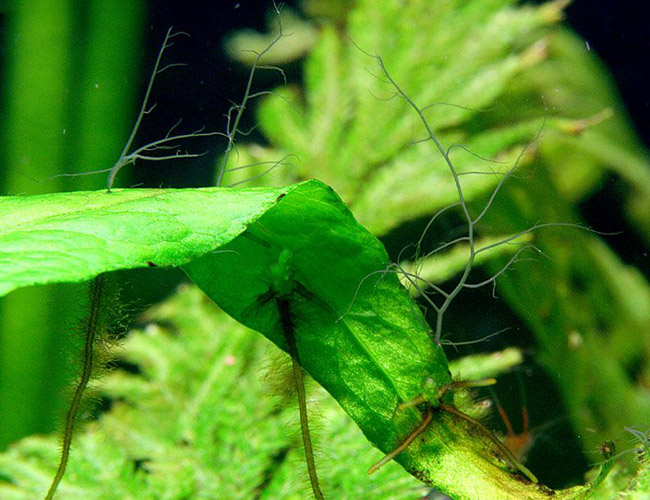
And below, you see the same Staghorn algae the day following just one spot dose of Excel…
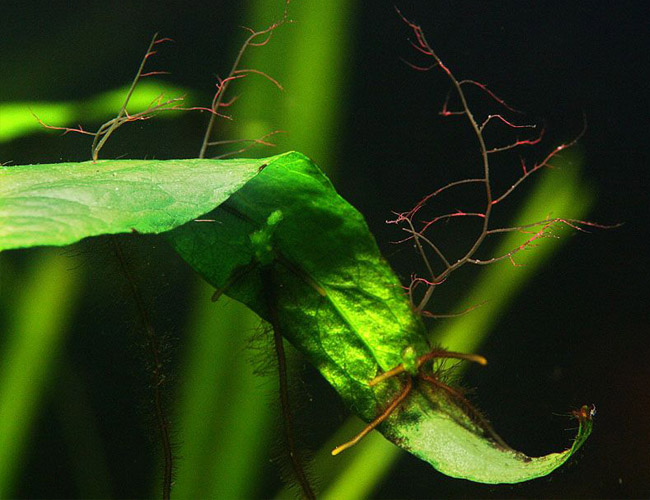
Continued spot dosing saw this outbreak clear up for good!
I personally love the fact that Staghorn algae changes color to red when it dies – it lets you know which areas you missed.
Staghorn algae eaters
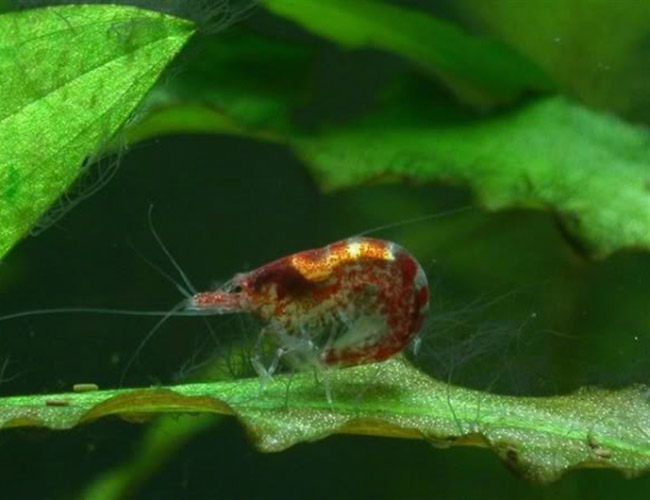
Wouldn’t it be great if you could just add a fish to your tank and have it get rid of the Staghorn algae for you?
Bad news…
At the time of writing this, I have not found a species of fish, shrimp or snail that will consistently eat Staghorn algae.
While your shrimp might nibble on it here and there, they won’t eat it to the point that it is eradicated.
However, after Staghorn algae dies, it is not uncommon to see shrimp feast upon its remains. If only they would eat the live stuff!
Conclusion
While it may not be harmful to fish, Staghorn algae can definitely have a negative impact on your plants. Not to mention that it looks ugly!
However, by taking proper care of your tank, you can prevent Staghorn algae from appearing in the first place.
How did you get rid of Staghorn algae? Let me know in the comments below!

Ian Sterling, founder of Fishlab.com, began his aquarium journey over 30 years ago, driven by a deep fascination for fish and their diverse personalities. His website, Fishlab.com, is dedicated to making fishkeeping accessible and enjoyable, offering beginner-friendly guidance, expert insights, and a community for aquarists to connect and share experiences.


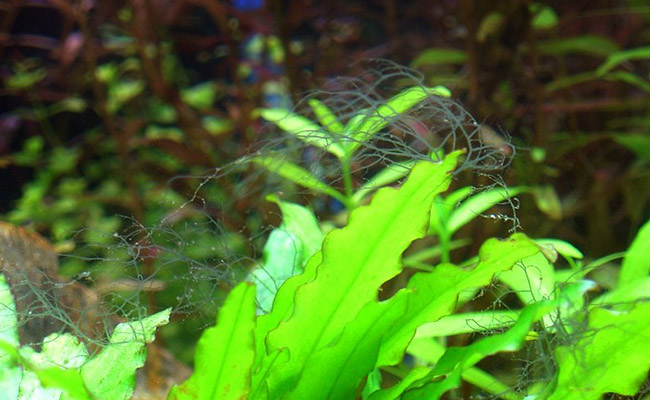
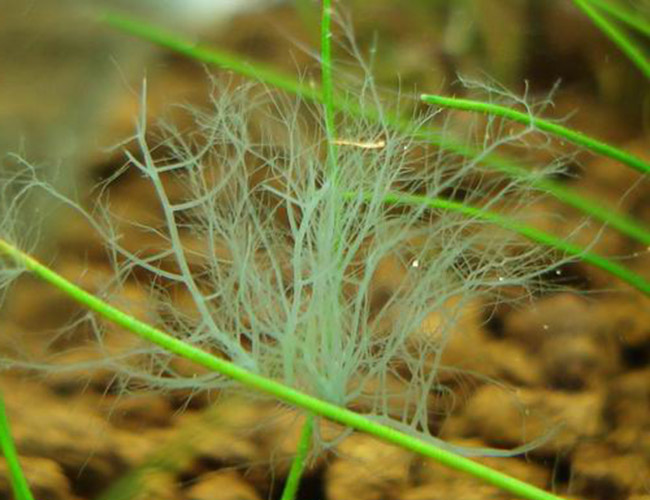
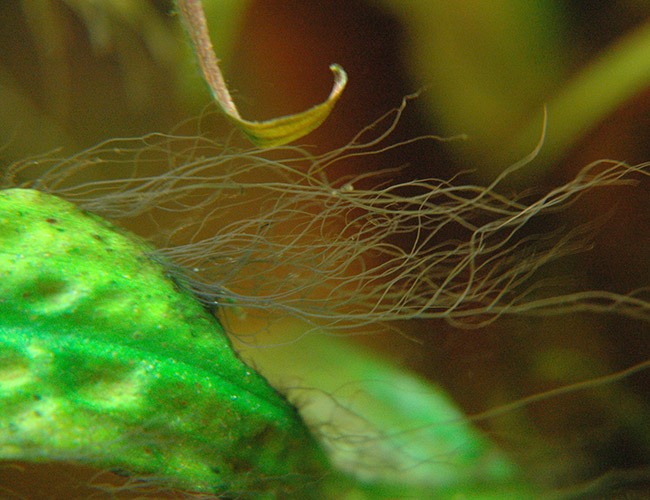
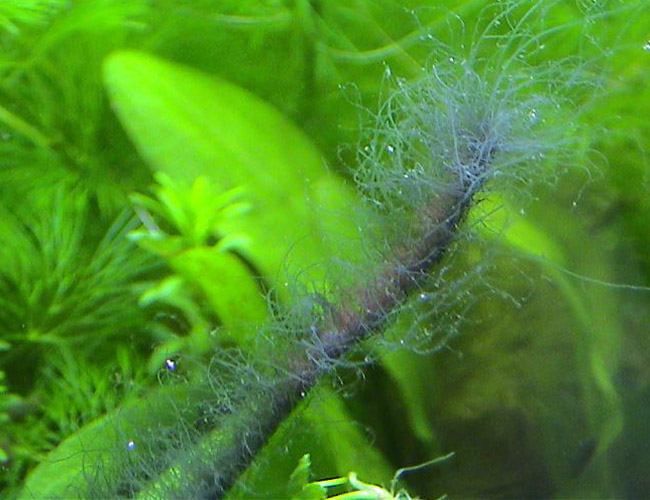
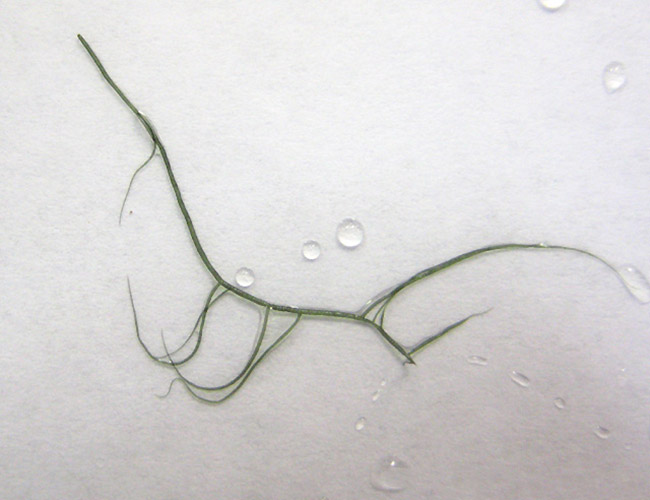
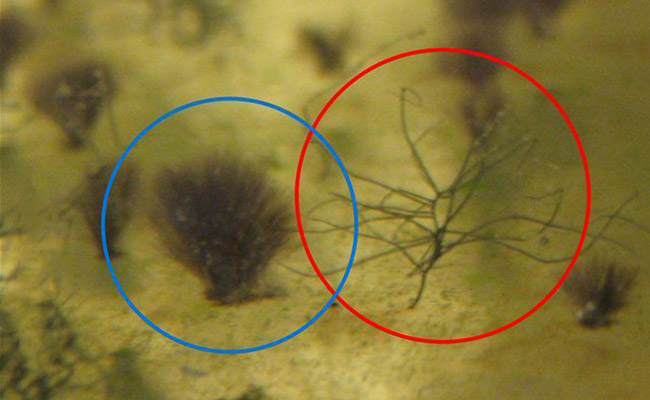
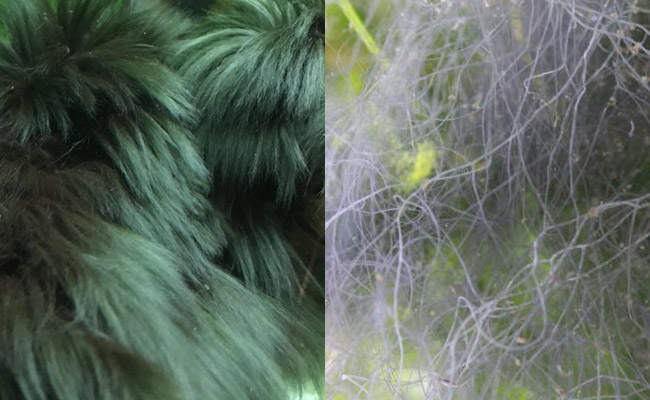
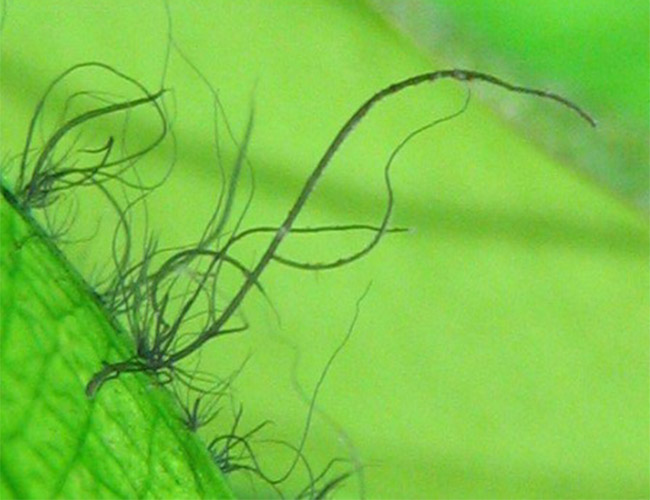
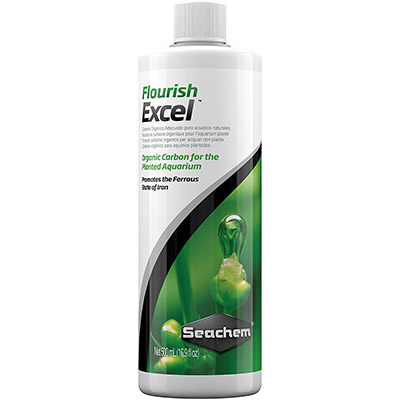
Comments (36)
After reading your article on Black Beard Algae, I had to discover what Staghorn Algae is.
I’ve had aquariums for 60 years and I have never seen Staghorn Algae in any of my tanks, but I have seen it in other peoples tanks.
It’s good to see that the solution for Staghorn Algae and Black Beard (Hair) Algae is the same.
I’ve been battling Hair Algae for some time now that was introduced from the purchase of a plant from one of the three LFS in this area.
I’ve already got other Flourish products (Iron, Comprehensive Supplement) so now I’ve got to get Excel and give it a try. Thanks.
Hi Gator,
Isn’t this hobby fantastic? I’ve been keeping fish for over 30 years and I am still learning new things all the time – and I’ve been doing this half as long as you. I would love to hear your experience with Excel.
I have been doing my tank with Excel and it works great. But how do I remove the dead allegra? Does it eventually disappear or should I manually take it out?
Hi Brandon,
It all depends on how much algae there was and what you have in your tank. Many shrimp, and some other algae eaters, will happily eat dead staghorn algae until there is none left. If it’s a little, it will slowly break up and go away on it’s own, with much of it being trapped in your filter. If it’s a lot, you might want to manually remove it, doing a small area at a time so you don’t gunk up the rest of your tank.
Hi, I’ve been keeping nano tanks for years now and this is the first time I’ve encountered stag horn algae. It seems that it has appeared over night. It’s only in a high flow area of one of my tanks and everything has been constant for 6 months so I’m not sure what’s changed it to make it grow. I’ll have to test my tap water to see if something changed there.
Thank you for this article it’s been very helpful and informative.
Hi Jess,
Isn’t surprise algae the worst? I hope testing your water sheds some light on the issue.
Hi i have a 60L aquarium so tge 1st time i dose spot dose ml for 40L. Then how about 2nd dose? Still use full dose? Or 1.5ml
Hi Boey,
If you need a follow up dose, I tend to do the same amount of h202.
Thanks .. it seems the algae still sticking around even spot treatment.
Lights at 4 hr, 10% weekly water change.
The 1st 2 time i use 5ml then 1.5 for 2 days. Total 4 days the algae still around.
Hi Boey,
Is any algae turning red and dying off? Are you sure it’s staghorn?
Hi Ian, sorry for the late reply. A lot of people says its staghorn https://m.facebook.com/groups/8673790658?view=permalink&id=10156747553320659
I treated wth spot treatment daily 5ml. For some It did turn red.
I also did a 2 day blackout and a few drops excel on 2liters bucket for my US fisside and some turn red and some green hair algae gone.
Now left a few stings for green hair algae and some staghorn around. Still doing 5ml daily dose.
Hi Again, Boey.
That sounds like you are making progress. The green hair algae might have to be manually removed, depending how long the strands are, and where it’s attached, you can probably remove it with a toothbrush
Thank you, I found this to be informative and very helpful.
Hi Jess,
Thank you for the kind words, I hope it solved your staghorn problem!
I’ve heard that small amounts of hydrogen peroxide will help. Is that true? Great article.
Ho Mona,
Yes, a good spot treatment of hydrogen peroxide will also work really well. However, I don’t recommend it to beginners. I have seen many newbies nuke their tank by either incorrectly applying it or following a youtube video that gave incorrect advice. It’s a lot harder to make a mistake with flourish excel. If you are confident, give it a go!
Hi Ian,
Have you tried treating different forms of algae with Easy-Life Algexit yet ?
Hi Spencer,
We don’t get many Easy-Life products over in the US, they are difficult to track down. Unfortunately because of this I don’t have a whole lot of experience with them other than what those over in the EU anecdotally say on forums.
Can I use the liquid co2 to combat the staghorn aswell as my co2 injection ?
Hi Steve,
Up front, I do not have personal experience adding liquid co2 while injecting it at the same time. I guess the big concern would be any fish you have. I would theorize that as you are keeping the total co2 in a habital zone, it should be fine.
I’ve kept my injected co2 at the same levels, whilst adding a small amount of easy carbo daily.started noticing the staghorn on the edges of leaves turning pink so im gradually upping the dose of the carbo for an even better result.dont want to dose to much too quickly and end up with a fish kill or any other related problems. Seems.to working so I’ll carry on.
thanks.
Hi Steven,
Thanks for the update. If the staghorn is turning pink it sounds like the treatment is working and it’s in the early stages of dying off.
Now its turned pink ,will it go away on it’s own or do I have to manually remove it ? Amano Shrimp and and nerite snails dont seem to be touching it.
Hi Steve,
Is the entire plant red/pink and dead? Or only parts. I have only seen algae eaters chomp on it when it’s completely dead. Also, if your nerites and shrimp are very well fed, they may be less inclined to eat it.
Hello, Ian Sterling. Thank you so much for posting this. Straight forward and easy to understand. Lol, helpful, too. I am raising some Caridina shrimp in a tank that has developed a few patches of staghorn algae that looks like pubic hair! I had no idea. Lol. My question is….Is it safe to use Excel Flourish with baby shrimp? They are 31 days old
Hi Tracy,
While it is invert safe (shrimp) I can only say anecdotally how it would affect baby shrimp. A member of of my local fish club has used flourish excel while the shrimp were breeding and with baby shrimp. The survival rate was as expected.
hello. i don’t know what’s going with my tank. some kind of algae but i couldn’t be sure. i really need help.
Hi Tim,
Unfortunately, there isn’t enough information here to provide insight into what you may be experiencing
Hi Ian,
I found this article on Staghorn algae,Thank You!
It’s plaguing my 30 gallon planted community tank. I’m dosing the full line of Seachem water additives, Flourish Advance, Flourish Excel, Iron, Potassium and Phosphorus in the recommended doses. My Light is on a timer, 8 hours a day. I just started running a pressurized CO2 tank, through an inline diffuser, into my Fluval 207 filter return line.
So there is the setup, I have about a dozen different types of plants in the tank, stems, mosses, Java Fern, Swords, Crypts. I’d say mostly the plants with the larger leaf areas are the ones with the Staghorn on them, and mostly the plants lower in the water column of the tank.
Now my question, should I up the CO2 injection a bit, while keeping it safe for the fish & shrimp in the tank, until I start to see the Staghorn turn pink, or with this just happen over time since the CO2 system is only about a week old.
Alternately, rather than spot dosing, could I pull the affected plants out an do a bucket dip with an Excel / Water mixture to treat the entire plant? Would there be any adverse effects, other that disturbing the setup of the tank and having to replant whatever I pull out to give a bath.
Hi Chad,
If you are doing a bucket dip, I recommend looking into h202. I can’t think of any downside to this except having to replant each plant, which depending on how much the staghorn algae has spread, may be a few of them.
Ok so would you do a mixture 50/50 water & peroxide, Or just 100% peroxide dip?
Hi Chad, I do a 3:1 water to peroxide dip for 6 minutes. Be mindful that this will work on algae and similar, but won’t kill some hitchikers such as snail eggs. I know many people use a 50/50 solution, but I have some sensitive plants and find the 3:1 works better for me.
Thank you very much very helpful article – great pictures, explanation and advice!
Hi
I’ve got staghorn algae, little bits popping up everywhere! Really pissing me off!. Manually cutting off affected leaves or removing it, daily. Lots of CO2 injection and dosing with Aquadesign Carbo at 2mls per 50lr but it’s not turning pink🫣😩. All liquid carbon products the same?
Reduced fertilizer dosing and lights by one-third.
Any other helpful pointer would be most grateful!
Hi, very informative.
I’ve tried every trick it the book to get rid of my STAGHORN algae!
Injecting Co2
Spot treating with hydrogen peroxide
Dosing flourish Excel
50%water changes & blowing out debris and sucking it out
Lights on 75%for 5.5 hours
E.I. method of fertilizer dosing but have reduced it by 1/4th.
Cutting off any infected leaves with it on.
It’s got a lot of plants in the tank
It’s not infested but it’s not going away!!!
Any other ideas?
I’m loosing hope
Hi Neil. Sounds like you’ve really been thorough in your efforts to combat staghorn algae! Have you considered reviewing your tank’s flow dynamics? Sometimes increasing water circulation can help prevent algae by distributing nutrients and CO2 more evenly. Also, double-check your tank’s nutrient balance. Lastly, give your tank some time to stabilize after these changes before you make further adjustments.